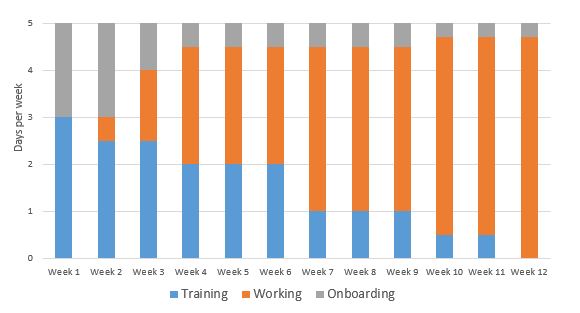You are a good manager.
You get how important employee onboarding is. And you would love to do it well. But deadlines are hurtling towards you at an alarming rate. There seems to be one crisis after another. Your team are working flat out just to keep their heads above water.
When you get new hires in, you just need them to take on some of the load as soon as they can.
The experts are right when they say that onboarding should be a priority. But right now so is that big launch next month, or that sales bid submission or that customer go live.
It is hard to prioritise onboarding when it is competing with activities that have dates that are set in stone.
Unfortunately it is the crazy busy teams, just like yours, that really need to onboard employees well. Because if you don’t, they are way more likely to leave. And you don’t want to start that hiring process all over again, do you?
So how on earth do you do it all?
How Do You Onboard New Hires When You Are Just So Busy?
The answer? Nothing is easy when you are that busy, but it can be done.
And you really have no choice.
According to the Wynhurst Group, 22% of staff turnover happens in the first 6 weeks. This period is critical.
Keeping your fingers crossed is not a proven strategy for keeping the great talent you worked so hard to find.
Why Bother with Onboarding?
It makes them smarter, faster.
A 2008 study by the Partnership for Public Service found that a structured onboarding programme actually “shortens the new employee’s learning curve, increasing productivity and reducing errors”
By teaching your new hire about the business, and not just their job, you give them purpose. They understand why they are doing what they are doing, the impact they have on others and the part they are playing in making the business successful.
And, to top that, these employees are more likely to stick around
“New employees that went through a structured onboarding programme were 58% more likely to be with the organisation after 3 years” Wynhurst Group.
The Secret of How to Do it All
I know. Statistics are one thing. Getting it done is another.
Here’s the secret. You don’t need to finish onboarding before your employee starts becoming the productive superstar you are hoping for.
Have you ever heard about 90 day onboarding programmes? You rolled your eyes didn’t you? With an ‘as if’ look on your face. And you might have muttered ’90 minutes would be good right now’ under your breath.
Well, here’s the thing. The 90 day plan is the busy manager’s friend. What you may not have noticed in these plans is that the employee gets operational a long time before the 90 days is up. (But they do give them longer than 90 minutes. Shame on you!)
You can concentrate on getting your new hire up to speed on the job he has to do. The trick is to shave off a few hours a week to focus on onboarding your new hire into the business.
The split of hours will be different for every job, but you get the idea. In this example, you start off devoting two days in the first week to showing your new hire the bigger picture and that reduces down to a couple of hours a week by the end of week twelve. Depending on the size and complexity of your business, you may not need twelve weeks.
The Onboarding Checklist for the Busy Manager
There is obviously a long list of things you would include if you weren’t running at the break neck speed you are. This is not meant to be the ultimate onboarding plan. But, when you are in this crazy busy place, it will be a lot more successful than just keeping your fingers crossed.
The actions below are in bite-sized chunks. They will be quick for you to plan and schedule and easy to fit into the time you have set aside each week for your new hire.
(If you’d like this in an editable checklist format, click here)
Making him feel valued
- Contact them before they start. Call them. Send them marketing goodies. Invite them for lunch. More ideas here
- Make sure your team knows they are coming
- Schedule items from the list in advance so their calendar is full when they arrive.
- Make sure the first day has structure. First impressions are hugely important. Schedule lunch with the team. Introduce him to the big boss. More ideas here
Helping him understand the importance of their role and your expectation
Schedule a one hour meeting with him for Day One. This is important to…….
- Talk through his responsibilities of his role and his key activities
- Tell him what your expectations are for the first three and six months
- Set out some measurable objectives so you both know how it is going
Scheduling in some time with him
- Book 15 minutes at the end of each day to catch up with him for the first two weeks
- Book in 30 minute catch ups twice a week for the next four weeks
- Invite him to shadow you in some meetings to give him better insight into the department or business
- Schedule a few lunches with him. Invite someone else for him to meet
Teaching him about the business, not just the job
- Walk him through the product/service lifecycle (or schedule in time with someone that can) Who designs it, makes it, delivers it, supports it.
- Walk them through the customer experience and the feedback you get from them
- Give them an organisational chart and make sure they understand what each department does
- Share some history and the goals for the business for the next few years
- Assign him a ‘buddy’ or ‘go to’ person to answer any day to day questions he has
Helping him understand how all the departments work together
- Schedule a meeting for him with one person from each department that he will interact with so he understands what they do
- Every role has a customer. Introduce him to his (whether that is internal or external) so he can find out how to help them be successful
- Help him understand how his work directly or indirectly impacts the business’ end customer
Helping him be successful
- Give him a heads up on any office politics that might trip him up
- Help him out with the acronyms and company jargon.
- Tell him who the ‘go to’ people are for key areas
Five Golden Rules to Make this Work
Let me leave you with a word of caution. Best intentions do not create the experience you are looking for here. Your best actions do. Here are five rules to ignore at your peril.
- Carve out time each week to give your new hire a well-rounded onboarding experience
- Schedule onboarding activities in advance or they will never happen
- Fit in as much as you can in early on – first impressions are critical
- Don’t skip them. These are critical for keeping your employee long term#
- Give your new hire a list of what their onboarding will include. This means that even though you are staggering it over a few weeks, they know it is coming.
But the most important thing about helping your new employee thrive, is the way you make them feel. Find patience even when your stress levels are high. Concentrate on making them a valued member of your team. Help them feel like they have made the right decision to join you.
I know you are busy, so I thought this might help. Click here to download three templates to save you a bit of time in your manic day.
- The Busy Manager’s Onboarding Checklist
- The Busy Manager’s 90 day Onboarding Schedule (an example)
- An example of an Onboarding Plan to give to your new hire (so they know what to expect)
Photo via VisualHunt.com





